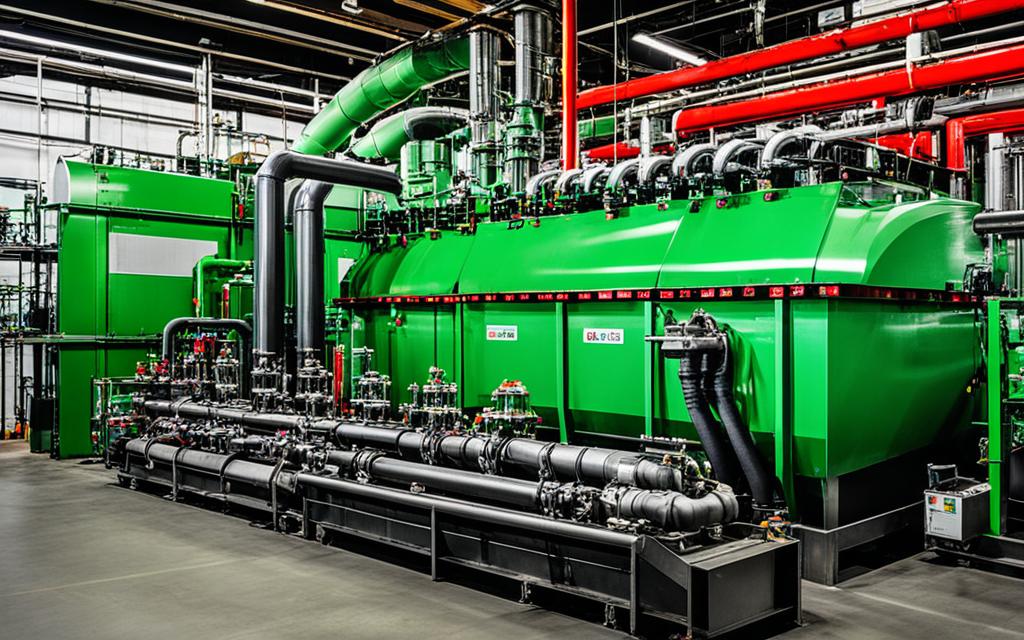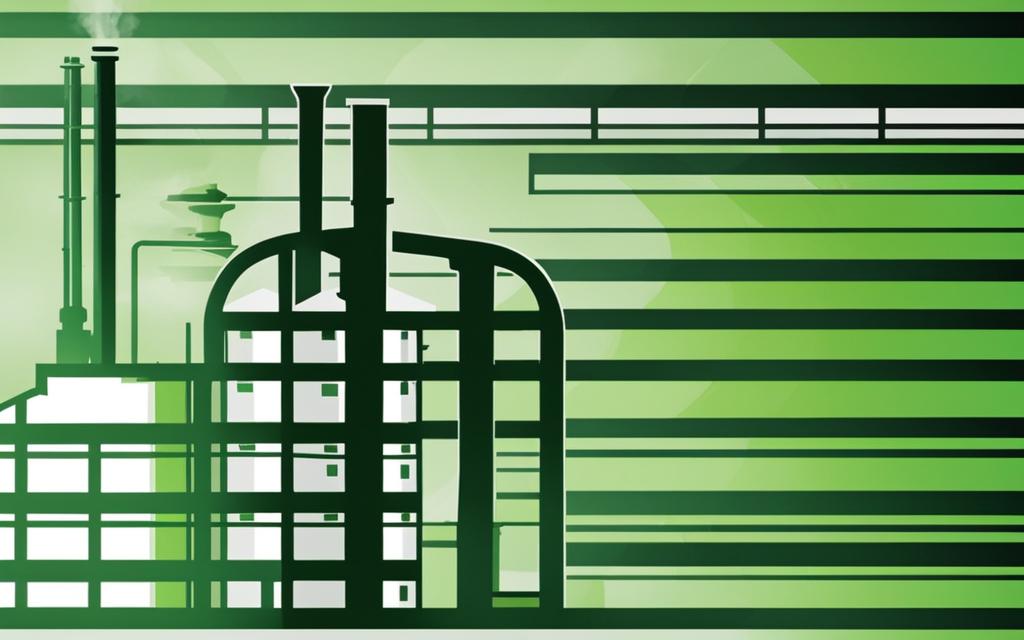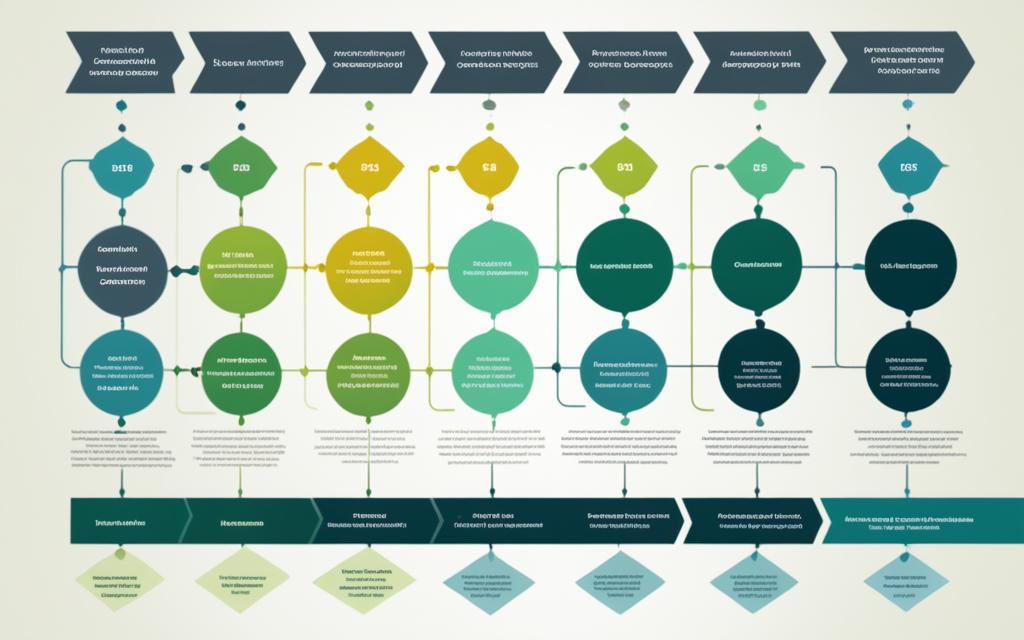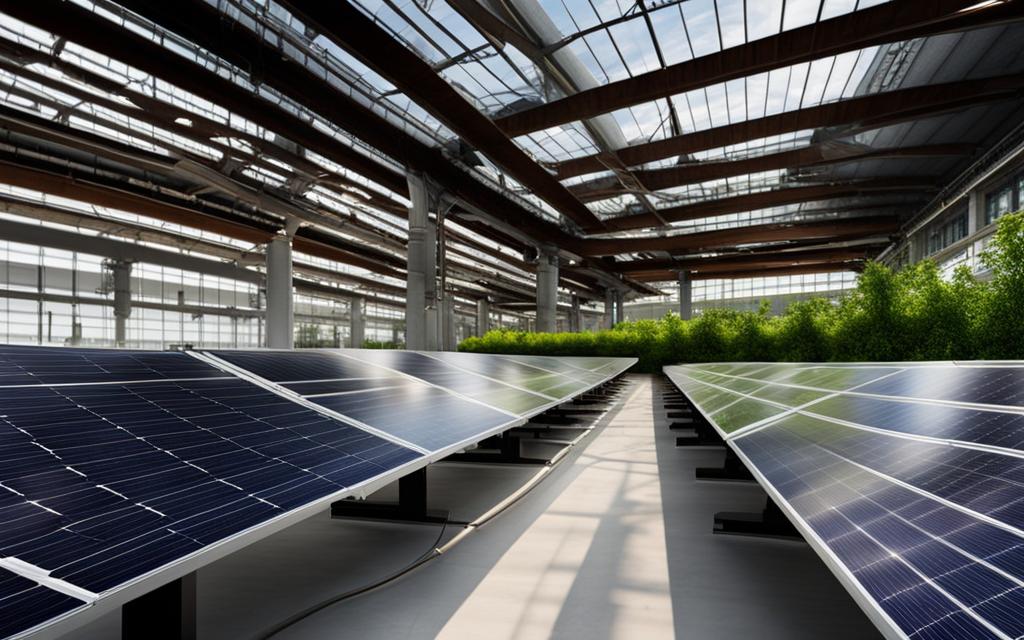
Quantifying The Carbon Footprint Reduction Achieved In Industrial Processes
The industrial realm faces increasing scrutiny over its role in climate change, with the building industry at the forefront due to its significant energy consumption and greenhouse gas emissions.
Constituting around 40% of global energy usage, the sector’s environmental impact is profound, emphasizing the urgency for carbon emissions reduction and industrial sustainability.
While carbon dioxide is the chief contributor at 97% of the total greenhouse gas metrics, concerted efforts in environmental impact quantification are crucial for setting clear reduction targets and strategies.
Global bodies such as the World Green Building Council (WorldGBC) are pioneering change, with ambitious goals for net-zero carbon emissions by 2050.
Achieving this requires a meticulous approach to tracking and managing emissions through Global Warming Potential (GWP) metrics.
These frameworks aid industries in creating actionable plans to mitigate their ecological footprint, integrating strategies that span from innovative design to the implementation of solvent recyclers to ensure resource efficiency.
Key Takeaways
- Understanding the severe environmental impacts of the construction sector is essential for setting sustainable targets.
- Meticulous emissions tracking, including the role of carbon dioxide, is key for effective carbon emissions reduction strategies.
- WorldGBC’s goal of net-zero carbon emissions by 2050 exemplifies the commitment required for industrial sustainability.
- The utilization of solvent recyclers is among the practical solutions for industries to enhance their environmental performance.
- GWP metrics serve as a standard for environmental impact quantification, guiding industries towards greener operations.
The Significance Of Carbon Footprint In Industrial Activities
Industrial growth and prosperity have long been key drivers of economic development, yet this progress comes with significant environmental responsibilities.
Leading the charge in environmental stewardship involves understanding and managing the overall carbon profile through carbon footprint assessment.
It is paramount for industries to not only recognize the scale of their GHG emissions but also to commit to industrial carbon reduction and embrace eco-efficient operations.
Understanding Carbon Footprint And Greenhouse Gases
The term ‘carbon footprint’ encapsulates the entire spectrum of greenhouse gases, including carbon dioxide, methane, nitrous oxide, and water vapor, attributed to an entity’s operational existence.
It is a measure that encompasses both direct emissions from owned or controlled sources and indirect emissions from the generation of purchased energy.
Aspects such as corporate supply chains, product usage, and disposal add layers to the complexity of a carbon footprint, creating the need for meticulous assessment protocols.
Industrial Processes And Their Environmental Impact
Amidst a growing environmental awareness, industries are scrutinized for their part in atmospheric GHG concentrations.
Manufacturing processes, logistics, and energy-intensive activities within sectors like construction represent a significant fraction of human-induced emissions.
Consequently, there is a surge in implementing international standards, like the Greenhouse Gas Protocol, which offers a comprehensive framework to measure, manage, and reduce greenhouse gas emissions.
Beyond regulatory compliance, industry leaders view carbon footprint assessment as an opportunity to refine process efficiency, reduce energy consumption, and solidify sustainability as a core business value.
Acknowledging that operational changes, like the adoption of solvent recyclers, can drastically reduce emissions, industries are motivated to transform traditional practices into innovative, green solutions.
Such commitment demonstrates a foundational shift towards a future where the pivot towards eco-efficiency is not just a regulatory expectation but a competitive differentiator.
Measuring Carbon Footprint Using Life Cycle Assessment (LCA)
Life Cycle Assessment (LCA) is now a pivotal tool in the arsenal of environmental responsibility, enabling an all-encompassing review of energy consumption in industry and the consequent operational carbon footprint.
This application of LCA furnishes a detailed examination of the environmental costs from the inception of a product to its ultimate disposition, habitually referred to as ‘cradle to grave’.
Principles Of Life Cycle Assessment In Industries
Industries are increasingly leveraging LCA to provide a comprehensive picture of their product’s environmental footprint.
The principles of LCA are grounded in the pursuit of sustainability and the reduction of carbon emissions.
An effective LCA application not only appraises the direct impacts of production but also encompasses the indirect effects, such as the sourcing of raw materials and end-of-life disposal.
LCA Methodologies’ Role In Quantifying Carbon Output
Through systematic LCA methodologies, industrial sectors are now able to measure the full spectrum of carbon emissions, from the energy-intensive production phase to the oft-overlooked disposal phase.
This thorough approach ensures that every aspect of a product’s life cycle is accounted for, allowing industries to identify and implement strategies that can significantly reduce their carbon footprint.
LCA is instrumental in spotlighting key areas where energy efficiency can be heightened and emissions curbed.
By delving into every stage of a product’s life, LCA highlights opportunities for enhancement that are frequently not apparent upon cursory examination.
This generates actionable data that supports decisions ranging from material selection to energy sourcing, ultimately helping to forge a less carbon-intensive path forward.
Moreover, LCA serves as a foundational module for the development of solvent recyclers and other energy-conserving tools.
By meticulously monitoring and quantifying emissions, LCA informs the design and implementation of systems that can recycle and reuse materials, thereby reducing the need for new resources and minimizing the operational carbon footprint.
In conclusion, an effective LCA has become an indispensable element in an ever-expanding range of industries committed to sustainable growth.
As the world grapples with the exigencies of climate change, LCA stands out as a robust framework for carbon emissions measurement, providing clarity and direction for environmentally-conscientious strategies.
The Role of Construction In Greenhouse Gas Emissions
The booming construction sector is a pivotal driver of the global economy but also a dominant contributor to climate change, with construction industry emissions perpetuating the rise in greenhouse gas (GHG) levels.
Focused on developing infrastructure and erecting edifices, the industry is at a critical junction, faced with the twin imperatives of expediting growth and curtailing its carbon footprint.
Energy Consumption And Emission Patterns In Construction
Defined by its reliance on energy-intensive materials, construction bears the weight of significant embodied energy in buildings.
Embodied energy refers to the sum total of energy necessary for the extraction, production, transportation, and installation of building materials, cumulatively leading to considerable emissions before a structure is even utilized.
Furthermore, operational emissions, the byproduct of a building’s energy use during its lifetime, accentuate the sector’s environmental impact, marking it as a critical arena for carbon mitigation efforts.
Challenges In Achieving Net-Zero Carbon By 2050
Aligning with the World Green Building Council’s galvanizing vision for a net-zero carbon future by the midpoint of the 21st century presents a formidable challenge.
This goal underscores the need for an industry-wide transformation, one that involves reinventing current practices, refining data measurement and assessment, and persistently pursuing efficiency and sustainability.
Innovating within this space, solvent recyclers contribute to reducing GHG emissions by recovering and repurposing valuable resources, epitomizing the potential of greener construction methodologies.
- Advances in precise data collection to quantify emissions accurately
- Enhancement in building design for energy efficiency and minimal waste
- Integration of renewable energy sources in building operations
- Policy frameworks that incentivize sustainable construction practices
- Education and training to upscale the workforce in green technology
These strategies and tools collectively forge a path toward the desired net-zero carbon targets.
The construction industry’s response to this existential call to action will profoundly shape our ecological legacy and the viability of our shared environmental future.
Streamlining LCA For Enhanced Accuracy And Practicability
Fostering environmental sustainability within the construction sector is increasingly pivotal, especially as we edge closer to the critical juncture of carbon neutrality.
Advances in life cycle emissions tracking, enhancement of LCA data accuracy, and integrating carbon neutrality tactics are not just aspirations but necessary steps toward mitigating ecological impacts.
Key to this transition is the improvement of life cycle assessment (LCA) methodologies, which hold the capacity to transform environmental impact improvements from an industry goal into a quantifiable reality.
Improving Data Collection In Lifecycle Analysis
The accuracy of a life cycle assessment is grounded in the integrity of its input data.
Reliable and comprehensive data is indispensable for assessing the true environmental footprint of construction projects. Industry leaders are now re-evaluating their data collection processes, seeking novel strategies to enhance precision, and minimize the scope of error.
For instance, gathering granular data regarding the energy consumption of machinery or emissions during material transportation is being given new emphasis, contributing to the overall sophistication of lifetime emissions profiles.

Addressing Assumptions And Uncertainties
Traditional methods often rely on a series of assumptions, which can introduce significant uncertainties within LCA results, potentially skewing the environmental impact assessment.
By critically examining and reducing the need for assumptions—such as default emission factors or generalized material impacts—environmental professionals are paving the way for more robust figures.
As we confront global climate targets, it is initiatives like these that solidify the practical approach to achieving carbon neutrality within the construction industry.
- Refinement of emission factor databases
- Utilization of real-time project data analytics
- Inclusion of technology-specific environmental information
Moreover, the incorporation of innovative tools and methodologies, such as solvent recyclers, into the LCA process not only contributes to enhanced accuracy but also promotes more sustainable industrial processes.
Reviewing Current Carbon Reduction Methods In Industry
The journey toward sustainable industrial operations has heightened the importance of robust carbon emissions quantification methods.
As industries strive to achieve net-zero strategies, the selection of an appropriate quantification framework becomes paramount in validating the impact of industrial carbon reduction techniques.
It is not simply a matter of regulatory compliance, but a strategic move towards innovation and long-term environmental stewardship.
Process-Based vs. Input-Output vs. Hybrid Methods
Three primary methodologies emerge when discussing the calculation of industrial greenhouse gas emissions: process-based, input-output, and hybrid approaches.
Process-based methods are meticulous, delving into operational specifics and targeting emissions from distinct processes.
Input-output methods, on the other hand, leverage economic data, providing a macro-scale analysis of emissions based on the monetary flow of products and services.
Hybrid methods attempt to synergize these two, capturing the detailed process information and the broader economic interactions.
The unique strengths and limitations of each approach underscore the necessity for innovation in low-carbon innovations to bolster precision and inclusivity in carbon emissions quantification methods.
Innovations In Carbon Emission Quantification
Innovation in quantification techniques seeks to ameliorate the disparities between these methods.
Advancing technologies like AI and blockchain offer new horizons for real-time monitoring and verifiable emissions tracking.
Furthermore, integrating such technologies can simplify adherence to regulatory frameworks and facilitate transparent reporting, a critical feature for stakeholder confidence.
With the commitment to net-zero strategies gaining global momentum, precise accounting of emissions is not just a legal obligation but a competitive imperative.
- Integration of AI for predictive analytics in emission hotspots.
- Use of blockchain for immutable emission data records.
- Internet of Things (IoT) devices for real-time tracking of energy consumption.
- Advanced software for streamlined LCA data collection and analysis.
- Employee training programs centered on sustainability measures.
As an example of enhancing recycling throughput, solvent recyclers demonstrate one of many burgeoning low-carbon innovations that contribute to industry’s pivotal role in curtailing carbon footprints.
Life Cycle Carbon Emissions: From Cradle To Cradle
Understanding the full scope of carbon emissions in the construction industry requires a granular look at each stage of a building’s life cycle.
The evaluation of life cycle carbon emissions enables stakeholders to identify critical phases where sustainable building practices can reduce overall environmental impact.
Central to this process is the life cycle carbon assessment, a systematic approach that scrutinizes the emission contributions of various construction materials throughout their life span.
Assessing Carbon Emissions Throughout The Construction Project Lifecycle
Integral to sustainable construction is the analysis of life cycle emissions, recognizing the profound influence each stage from material extraction to end-of-life disposal has on a building’s carbon footprint.
Professionals in the field employ life cycle assessments (LCAs) with meticulous inventory data collection to ensure each phase of construction is optimized for minimal environmental disruption.
This inclusive assessment aims to support the global transition to emission-intensive materials with lower carbon profiles.
Common Construction Materials And Their Environmental Impact
Focusing on the emissions intrinsic to common construction materials, the construction industry has identified materials such as concrete, steel, cement, timber, and glass as significant contributors to the industry’s carbon footprint.
Each material’s production chain offers different opportunities and challenges in reducing greenhouse gas emissions.
For example, solvent recyclers may play a part in minimizing emissions during the manufacturing processes by reclaiming chemicals for reuse.
Shaping a sustainable future for construction may well depend on reimagining how these core materials are produced, used, and recycled.
Given the magnitude of construction material emissions, sustainable building practices strive to balance the need for durability and function with the imperative of environmental stewardship.
By integrating eco-friendly design principles, leveraging upcycled and recycled materials, and exploring innovative construction techniques, industry practitioners are at the forefront of reducing life cycle carbon emissions—one structure at a time.
Systematic Review Using PRISMA: Issues And Improvements
The growing awareness around climate change has spurred industries to reimagine their processes, especially in carbon management in construction.
The application of the Preferred Reporting Items for Systematic Reviews and Meta-Analysis (PRISMA) aids in addressing the challenges and enhancing the quality of LCA publications, which are integral to assessing and minimizing environmental impacts.
Evaluating Life Cycle Carbon Emissions Quantification
In the quest for precision in carbon emission measurement, PRISMA systematic reviews have been instrumental.
They serve as a roadmap for researchers navigating through the complex terrain of life cycle carbon emissions data.
By adhering to its criteria, scholars are better positioned to identify disparities and methodological inconsistencies, ensuring the fidelity of conclusions drawn from LCA studies.

Guiding Future Life Cycle Carbon Emissions Research
Future research in carbon management in construction is poised for refinement guided by the insights provided by PRISMA.
The systematic review’s framework offers a standardized approach to evaluate past work and directs fresh endeavours towards closing knowledge gaps.
This process nurtures a research environment ripe for innovation, driving the industry closer to sustainable, low-carbon design solutions.
Fostering an evidence-based foundation for low-carbon strategies and policies is the cornerstone of PRISMA’s value in environmental research.
Indirect Emissions In Industrial Process Evaluation
The comprehensive approach to carbon footprint management necessitates the evaluation of both direct and indirect emissions linked to industrial activities.
Unlike direct emissions, which occur from sources that are directly controlled by an entity, indirect emissions manifest through the broader value chain of products and services.
It’s in this expanded view that the environmental policy influence becomes apparent, steering industrial benchmarks for sustainability.
Assessing Downstream Impact On Carbon Footprint
An indirect emission assessment encapsulates all emissions that occur due to the consumption of an organization’s goods and services.
From the manufacturing of raw materials to the disposal of end products, these emissions can significantly alter the total carbon footprint of a company.
Recognizing the importance of downstream impacts enables businesses to implement comprehensive strategies that address every facet of their influence on the environment.
Policy Implications And Greenhouse Gas Auctions
Environmental policies and GHG trade mechanisms are levers driving the advancement of emissions reductions.
Policies incentivize companies to look beyond their immediate operations and consider the lifecycle emissions of their products.
Greenhouse gas auctions serve as a crucial tool for industry-wide engagement in carbon markets, where the cost of emissions spurs innovation and investment in carbon-efficient technologies.
Highlighting the role of solvent recyclers in reducing emissions, these policies contribute to a more circular economy.
The indirect evaluation of emissions is an expanding frontier in environmental management and underscores the nuanced complexities of achieving meaningful reductions in an organization’s carbon footprint.
It’s through understanding and action on these indirect emissions that industries can truly make a collective stride towards environmentally sustainable practices.
Integrating Sustainable Industrial Practices
The burgeoning field of sustainable industry practices has reached a pivotal juncture, as both private enterprises and public entities recognize the integral role that green design architecture and energy-efficient materials play in modern construction.
To facilitate this transformative path, it is essential to fortify the synergy between innovative sustainable construction technologies and supportive governmental frameworks.

Role Of Energy-Efficient Building Design And Innovations
In the quest for sustainability, attention has turned toward embedding energy-efficiency innovations into the very blueprints of new structures.
These designs not only draw from advances in technology but also reimagine the application of traditional techniques for modern context—an amalgamation poised to dramatically reduce ecological footprints without yielding the functional essence of the edifice.
The canvas of energy-efficient design is vast, stretching from insulation choices to smart grid-compatible electrical systems, each element acting as a critical cog in the sustainability machinery.
Government Policies And Incentives For Sustainability
Governmental incentives play an undeniable role in the propulsion of green building policies forward.
Through a constellation of environmental incentives, pioneering firms are incited to embark on eco-friendly projects, wielding the double-edged sword of innovation and responsibility.
Prospects such as tax rebates, subsidies, or expedited permits act as compelling motivators that steer the industry towards a green horizon.
This governmental backing is potent; it coalesces the might of public resources with the agility of the private sector to erect monuments of sustainability that stand the test of time and tides.
By strengthening the pillars that support the grand edifice of sustainable industry practices, entities across the spectrum—be they architects, developers, or solvent recyclers—contribute to a cohesive approach that fortifies the environmental integrity of construction activities and provides a template of growth that balances industrial progress with ecological prudence.
Case Studies In Construction Carbon Footprint
In an era where carbon reduction is not just a goal but a necessity, the construction industry stands as a pivotal player.
Groundbreaking case studies in carbon reduction showcase the real-world impact of sustainable practices and underscore the urgency of addressing lifecycle carbon output with precision and innovation.
As these studies dissect the high-impact construction materials at the heart of their inquiry, they reveal not only the challenges but also the strides made in this critical field.
Assessing Carbon Output In High-Impact Materials
Construction is a resource-intensive industry, with materials such as cement, steel, and concrete dominating the landscape.
The processing and use of these materials are beset with high carbon costs, making their assessment vital for any meaningful carbon footprint analysis.
Building on a solid database of international projects, it becomes visible how high-performance materials and technologies are rewriting the narrative of sustainable construction.
Overcoming Data Limitations In Carbon Footprint Analysis
Data is the backbone of carbon output evaluation. However, overcoming data challenges remains a daunting task.
Inaccuracies in data collection, coupled with variable methodologies, can lead to significant discrepancies in results.
As solvent recyclers represent a paradigm shift in sustainable industrial processes, a similar innovation-focused approach is necessary for fine-tuning data analytics in the construction sector.
Utilizing rigorous frameworks, industry leaders are progressively achieving data consistency for rigorous lifecycle analyses.
- Integrating evolving technologies for on-site carbon measurement.
- Enhancing transparency and uniformity in reporting carbon metrics.
- Advocating for strong policy interventions that support data-oriented sustainability initiatives.
By diving into the specifics of these case studies, we gain a clearer understanding of the breadth of solutions at our disposal and the progress already underway.
The construction sector’s commitment to this cause exemplifies a promising trajectory towards a more resilient and sustainable future.
Leveraging Modern Technology To Reduce Carbon Emissions
The integration of modern technology in carbon reduction is shaping the future of industrial processes, harnessing innovative approaches to achieve more sustainable operations.
As industries grapple with the complexities of innovative emission control, they are increasingly turning to advancements in technology that enable significant strides towards environmental stewardship.

From automation to digitalization and data analytics, the evolution of these elements plays a pivotal role in enhancing operational efficiency.
These technological interventions are not only driving progress in reducing emissions but also propelling forward industrial environmental strategies that align with global sustainability commitments.
Within this context, automation stands out as a transformative force.
By optimizing processes and reducing the need for energy-intensive manual operations, industries can minimize their carbon footprint.
Additionally, digitalization has revolutionized the management of environmental data, enabling companies to track their emissions in real-time and adapt their processes for better emission controls.
Embracing sustainable tech advancements is not a mere trend but a strategic imperative for industries committed to reducing their environmental impact and contributing positively to global carbon reduction efforts.
- Implementation of artificial intelligence for energy savings
- Development of smart grids for optimized energy distribution
- Advances in material science leading to lighter, stronger, and more efficient materials
Moreover, industries such as manufacturing have begun to explore the potential of solvent recyclers to minimize waste and reduce emissions associated with solvent use.
By reclaiming and reusing solvents, these recycling systems underscore the role that targeted technologies can play in a comprehensive approach to carbon reduction.
In conclusion, the journey towards a greener industrial landscape is being paved with the stones of modern technological innovation.
It is through these advancements that industries can not only envision but actively create a more sustainable future.
Implementing Solvent Recyclers For Sustainable Industrial Processes
In the pursuit of sustainable solvent operations, the introduction of solvent recyclers into industrial workflows illustrates a commitment to environmental stewardship and economic efficiency.
These systems advocate for solvent recycling benefits that extend beyond regulatory compliance, fostering a culture of cleaner production methodologies and leading to a reduction in waste and emissions.
Within the scope of industrial manufacturing, the reuse of solvents presents various economical and ecological advantages.
Industries looking to integrate more eco-friendly solvent handling protocols are turning to solvent recyclers as a viable solution to meet both internal sustainability objectives and external environmental demands. The advantages are manifold:
- Decreased hazardous waste generation, reducing the need for disposal and thus minimizing environmental pollution.
- Lower consumption of virgin materials, conserving natural resources and curtailing production costs associated with solvent purchase.
- Enhanced worker safety by reducing exposure to harmful chemicals, thanks to contained recycling processes.
- Compliance with stringent environmental regulations, positioning companies as leaders in eco-responsibility.
The utilization of solvent recyclers aligns with the global shift towards a circular economy, which prioritizes the regeneration and continual use of resources.
By implementing these recyclers, industries are able to conserve resources and move towards a future where sustainable operations are not just an aspiration but a norm.
Industry leaders recognize that eco-efficient operations pave the way for a sustainable competitive edge, mitigating risks associated with volatile commodity pricing and stringent environmental oversight.
As industries endeavor to diminish their carbon footprint, the role of solvent recyclers becomes paramount.
Not only do they serve to conserve resources, but they also act as a critical component in achieving the dual objectives of operational efficiency and environmental preservation.
As we encapsulate the strides taken towards minimizing the environmental repercussions of industry, the construction sector emerges with marked improvements.
This sector’s journey of summarizing emission reductions attests to the steadfast commitment and transformative measures that have undergirded its progress.
Harnessing a conglomerate of innovative methodologies and bolstered by government incentives, the industry has seen tangible success in diminishing its ecological footprint.
Summarizing Carbon Footprint Reduction Achievements
Industrial sustainability achievements have not only provided a roadmap for other sectors but have also illustrated the collaborative synergy between technological ingenuity and policy frameworks.
Instrumental in these achievements is the meticulous quantification and strategic management of carbon output, which acts as both a milestone and a marker for future enhancements.
These concerted efforts across various sectors have forged an upward trajectory towards significant emissions mitigation, reinforcing the notion of a resilient and adaptive industrial landscape.
Forward Path To Industrial Sustainability And Net-Zero Goals
Moving towards a net-zero future depends on the persistence of innovation, the acceleration in the adoption of sustainable technologies such as solvent recyclers, and improvements to emission quantification methods.
Embracing a holistic and integrated approach to sustainability, the industry is capable of upholding its commitment to a healthier planet.
By continually pushing carbon footprint milestones further, a sustainable, net-zero carbon reality becomes more achievable, setting a precedence for industrial responsibility and environmental consciousness.